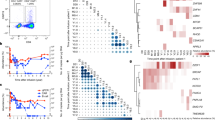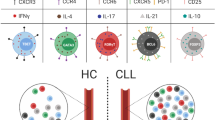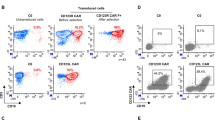Abstract
Immunotherapy utilizing CAMPATH-1H for patients with chemotherapy-refractory chronic lymphocytic leukemia has yielded encouraging results with many reports of complete remission. Here we report the outcome of two patients with CD4-positive T cell prolymphocytic leukemia treated with CAMPATH-1H. Both patients responded rapidly to treatment and subsequently developed CD4 lymphopenia. One patient remained in complete remission after 14 weeks of treatment. Serial peripheral blood flow cytometry revealed that the CD52 antigen was present throughout treatment. The other patient who was initially CD52-positive, became CD52-negative after 6 weeks of treatment, and developed progressive symptoms of T cell prolymphocytic leukemia. Immunotherapy was stopped, chemotherapy proved futile, and the patient died. This change in phenotype from CD52-positive to -negative during CAMPATH-1H therapy points out a need to develop strategies for maintaining antigenic expression during monoclonal antibody therapy.
This is a preview of subscription content, access via your institution
Access options
Subscribe to this journal
Receive 12 print issues and online access
$259.00 per year
only $21.58 per issue
Buy this article
- Purchase on Springer Link
- Instant access to full article PDF
Prices may be subject to local taxes which are calculated during checkout

Similar content being viewed by others
References
Xia MQ, Hale G, Lifely MR, Ferguson MA, Campbell D, Packman L, Waldmann H . Structure of the CAMPATH-1 antigen, a glycosylphosphatidylinositol-anchored glycoprotein which is an exceptionally good target for complement lysis Biochem J 1993 293: 633–640
Hale G, Xia MQ, Tighe HP, Dyer MJ, Waldmann H . The CAMPATH-1 antigen (CDw52) Tiss Antigen 1990 35: 118–127
Gilleece MH, Dexter TM . Effect of Campath-1H antibody on human hematopoietic progenitors in vitro Blood 1993 82: 807–812
Dyer MJ, Hale G, Marcus R, Waldmann H . Remission induction in patients with lymphoid malignancies using unconjugated CAMPATH-1 monoclonal antibodies Leuk Lymph 1990 2: 179–193
Ginaldi L, DeMartinis M, Matutes E, Farahat N, Morilla R, Dyer MJ, Catovsky D . Levels of expression of CD52 in normal and leukemic B and T cells: correlation with in vivo therapeutic responses to Campath-1H Leuk Res 1998 22: 185–191
Dyer MJ, Hale G, Hayhoe FG, Waldmann H . Effects of CAMPATH-1 antibodies in vivo in patients with lymphoid malignancies: influence of antibody isotype Blood 1989 73: 1431–1439
Isaacs JD, Watts RA, Hazleman BL, Hale G, Keogan MT, Cobbold SP, Waldmann H . Humanised monoclonal antibody therapy for rheumatoid arthritis Lancet 1992 340: 748–752
Bindon CI, Hale G, Waldmann H . Importance of antigen specificity for complement-mediated lysis by monoclonal antibodies Eur J Immunol 1988 18: 1507–1514
Riechmann L, Clark M, Waldmann H, Winter G . Reshaping human antibodies for therapy Nature 1988 332: 323–327
Crowe JS, Hall VS, Smith MA, Cooper HJ, Tite JP . Humanized monoclonal antibody CAMPATH-1H: myeloma cell expression of genomic constructs, nucleotide sequence of cDNA constructs and comparison of effector mechanisms of myeloma and Chinese hamster ovary cell-derived material Clin Exp Immunol 1992 87: 105–110
Dick AD, Meyer P, James T, Forrester JV, Hale G, Waldmann H, Isaacs JD . Campath-1H therapy in refractory ocular inflammatory disease Br J Ophthalmol 2000 84: 107–109
Curtis RE, Travis LB, Rowlings PA, Socie G, Kingma DW, Banks PM, Jaffe ES, Sale GE, Horowitz MM, Witherspoon RP, Shriner DA, Weisdorf DJ, Kolb HJ, Sullivan KM, Sobocinski KA, Gale RP, Hoover RN, Fraumeni JF Jr, Deeg HJ . Risk of lymphoproliferative disorders after bone marrow transplantation: a multi-institutional study Blood 1999 94: 2208–2216
Dyer MJ . The role of CAMPATH-1 antibodies in the treatment of lymphoid malignancies Semin Oncol 1999 26: 52–57
Cull GM, Haynes AP, Byrne JL, Carter GI, Miflin G, Rebello P, Hale G, Waldmann H, Russell NH . Preliminary experience of allogeneic stem cell transplantation for lymphoproliferative disorders using BEAM-CAMPATH conditioning: an effective regimen with low procedure-related toxicity Br J Haematol 2000 108: 754–760
Matutes E . T-cell prolymphocytic leukemia Cancer Control 1998 5: 19–24
Pawson R, Dyer MJ, Barge R, Matutes E, Thornton PD, Emmett E, Kluin-Nelemans JC, Fibbe WE, Willemze R, Catovsky D . Treatment of T-cell prolymphocytic leukemia with human CD52 antibody J Clin Oncol 1997 15: 2667–2672
Catovsky D . Clinical experience with 2′-deoxycoformycin Hematol Cell Ther 1996 38 (Suppl. 2): S103–S107
Hertenstein B, Wagner B, Bunjes D, Duncker C, Raghavachar A, Arnold R, Heimpel H, Schrezenmeier H . Emergence of CD52-, phosphatidylinositolglycan-anchor-deficient T lymphocytes after in vivo application of Campath-1H for refractory B-cell non-Hodgkin lymphoma Blood 1995 86: 1487–1492
Brett SJ, Baxter G, Cooper H, Rowan W, Regan T, Tite J, Rapson N . Emergence of CD52-, glycosylphosphatidylinositol-anchor-deficient lymphocytes in rheumatoid arthritis patients following Campath-1H treatment Int Immunol 1996 8: 325–334
Davis BH, Foucar K, Szczarkowski W, Ball E, Witzig T, Foon KA, Wells D, Kotylo P, Johnson R, Hanson C, Bessman D . US–Canadian Consensus recommendations on the immunophenotypic analysis of hematologic neoplasia by flow cytometry: medical indications Cytometry 1997 30: 249–263
Harris NL, Jaffe ES, Stein H, Banks PM, Chan JK, Cleary ML, Delsol G, De Wolf-Peeters C, Falini B, Gatter KC . A revised European–American classification of lymphoid neoplasms: a proposal from the International Lymphoma Study Group Blood 1994 84: 1361–1392
Taylor VC, Sims M, Brett S, Field MC . Antibody selection against CD52 produces a paroxysmal nocturnal haemoglobinuria phenotype in human lymphocytes by a novel mechanism Biochem J 1997 322: 919–925
Rowan W, Tite J, Topley P, Brett SJ . Cross-linking of the CAMPATH-1 antigen (CD52) mediates growth inhibition in human B- and T-lymphoma cell lines, and subsequent emergence of CD52-deficient cells Immunology 1998 95: 427–436
Davis TA, Czerwinski DK, Levy R . Therapy of B-cell lymphoma with anti-CD20 antibodies can result in the loss of CD20 antigen expression Clin Cancer Res 1999 5: 611–615
Hellerstein M, Hanley MB, Cesar D, Siler S, Papageorgopoulos C, Wieder E, Schmidt D, Hoh R, Neese R, Macallan D, Deeks S, McCune JM . Directly measured kinetics of circulating T lymphocytes in normal and HIV-1-infected humans Nature Med 1999 5: 83–89
Bunjes D, Theobald M, Wiesneth M, Schrezenmeier H, Hoffmann T, Hertenstein B, Arnold R, Heimpel H . Graft rejection by a population of primed CDw52-host T cells after in vivo/ex vivo T-depleted bone marrow transplantation Bone Marrow Transplant 1993 12: 209–215
Acknowledgements
This work was supported in part by a grant from the Marshfield Medical Research Foundation and funds from Millennium and ILEX Partners, Cambridge, MA, USA. We would like to thank Esoterix Oncology for its continued assistance on the interpretation of these cases, and acknowledge support provided by the Marshfield Medical Research and Education Foundation through the assistance of Graig Eldred and Alice Stargardt for manuscript preparation.
Author information
Authors and Affiliations
Rights and permissions
About this article
Cite this article
Birhiray, R., Shaw, G., Guldan, S. et al. Phenotypic transformation of CD52pos to CD52neg leukemic T cells as a mechanism for resistance to CAMPATH-1H. Leukemia 16, 861–864 (2002). https://doi.org/10.1038/sj.leu.2402471
Received:
Accepted:
Published:
Issue Date:
DOI: https://doi.org/10.1038/sj.leu.2402471
Keywords
This article is cited by
-
CCR7 as a novel therapeutic target in t-cell PROLYMPHOCYTIC leukemia
Biomarker Research (2020)
-
Early emergence of PNH-like T cells after allogeneic stem cell transplants utilising CAMPATH-1H for T cell depletion
Bone Marrow Transplantation (2005)
-
Innovative strategies in lymphoma therapy
Wiener Klinische Wochenschrift (2003)



